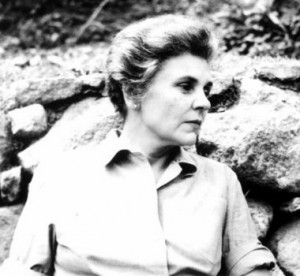 Is the end of life best imagined as a climactic release? Although not explicitly about death, Elizabeth Bishop’s poem “Sonnet” all but dramatizes it as a swift vault from captivity to liberation as the poem depicts the soul’s gleeful escape from “caught” (1) to “freed” (5). “Sonnet” dilates the instantaneous moment between life and death, and it does so with delight.
Is the end of life best imagined as a climactic release? Although not explicitly about death, Elizabeth Bishop’s poem “Sonnet” all but dramatizes it as a swift vault from captivity to liberation as the poem depicts the soul’s gleeful escape from “caught” (1) to “freed” (5). “Sonnet” dilates the instantaneous moment between life and death, and it does so with delight.
Bishop pins down this whimsical journey with sharply defined images. She uses a spirit level, compass, thermometer and mirror—instruments with which the subjective mind comprehends the objective world. Already conduits between the physical and metaphysical, these objects now measure emotional dimensions—a hopeless task:
Caught—the bubble
in the spirit-level,
a creature divided;
and the compass needle
wobbling and wavering,
undecided. (1-6)
An ordinary tool for home improvement, the small gasp of air in a “spirit-level” becomes the soul’s confinement in the flesh. “A creature divided” further intimates this mind/body dualism. If read more practically, the poet relents from the attempt to choose the right path. Our devices point toward no steady direction.
But the gadgets of navigation break. The mind, the imagination and the soul run free. Death happens between lines 6 and 7; the exact moment of the soul’s departure is a blind spot. Liberated, the speaker passes through this sudden, unknowable void with elation:
Freed—the broken
thermometer’s mercury
running away;
and the rainbow-bird
from the narrow bevel
of the empty mirror,
flying wherever
it feels like, gay! (7-14)
When the mercury drains, the thermometer’s temperature, like the body’s upon dying, drops. Who hasn’t felt the prison of the body? Perhaps it feels more like one with age. My grandfather seemed to think so. He loathed getting old—he told me so. His body must have felt like an anchor rusting at the bottom of the sea, or a chrysalis when the butterfly suddenly becomes aware of its wings. He stopped eating a few weeks before his death. Though he’d been losing his mind, I believe my grandfather chose his own end with whatever threads of consciousness remained. Surrounded by his wife and children, was his death a great release, a wondrous sigh into whatever was next to be endured? I wasn’t there. I don’t know.
First published in the The New Yorker in 1979, three weeks after the poet’s death, “Sonnet” is often considered Elizabeth Bishop’s last poem. What an image to conclude her luminous career—the “empty mirror” from which the iridescent bird flies away. According to poet Lloyd Schwartz, Bishop “hated the way she looked, hated looking at herself,” an impression which gives this vacancy a special poignance. The poet is free from her own image at last. As the least tangible of her images, is this bird a ray of light? Is it the soul? It finds, at any rate, in the liminal space between reality and its reflection, freedom and gaiety never felt before.
Read more from The Next Chapter:

 “Sonnet” by Elizabeth Bishop
“Sonnet” by Elizabeth Bishop



 First the Wealth Gap, Now the U.S. Has a Growing Health Gap
First the Wealth Gap, Now the U.S. Has a Growing Health Gap
 How to Comfort A Dying Loved One
How to Comfort A Dying Loved One
 Our Annual Seven Holiday Gifts for Someone Who Is Grieving, 2024 Edition
Our Annual Seven Holiday Gifts for Someone Who Is Grieving, 2024 Edition














